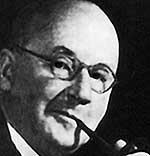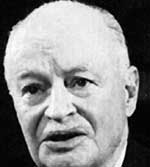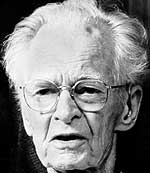In 1887, Cattell traveled to England, where he befriended psychologist Sir Francis Galton, known as the “British Wundt.”12 He was impressed with Galton’s theory that “man’s natural abilities are derived by inheritance.”13
Galton coined the word “eugenics,” from the Greek eugenes meaning “wellborn” or “good in stock,” and founded the eugenics movement. He asserted that mating practices should “give more suitable races or strains of blood a better chance of prevailing speedily over the less suitable.”14
After traveling to Africa, Galton wrote of one tribe: “These savages court slavery.... You engage one of them as a servant, and you find that he considers himself as your property, so that you become the owner of a slave. They have no independence about them, generally speaking, but follow a master as a spaniel would.”15
Galton’s eugenics theories — forwarded by psychiatrist Ernst Rudin, among others — provided the impetus for Germany’s racial hygiene and genocide programs, which led to the death of millions of innocents.
After digesting Galton’s ideas on race, eugenics and selective breeding, Cattell returned to America to become the world’s first psychology professor and the first psychologist to administer psychological tests to large groups of students. And as eugenics grew in influence, Cattell wrote to Galton, “We are following in America your advice and example.”16
Exterminating “Feeble-Mindedness”
|
“If an
unfriendly foreign power had attempted
to impose on America the mediocre educational performance that exists today, we might well have viewed it
as an act of war.”
— “A Nation at Risk,” National Commission on Excellence in Education, April 1983 |
Terman envisioned how such testing would be used: “In the near future intelligence tests will bring tens of thousands of these high-grade defectives under the surveillance and protection of society.
“This will ultimately result in curtailing the reproduction of feeble-mindedness and in the elimination of an enormous amount of crime, pauperism and industrial inefficiency. ... [These] are precisely the ones whose guardianship it is the most important for the State to assume.”17
Thus, Wundt, Hall, Dewey, Thorndike, Cattell and their colleagues set the stage for social engineering of those “whose guardianship it is the most important for the state to assume” — America’s youth. The decline of American education followed as their behavioral modification methods supplanted learning.
Today, decades later, their “educational psychology” lives on, along with institutions and professional journals that promote the idea that psychology can shape a child’s behavior as easily as a laboratory rat’s.
Attacking the Teaching Profession
Following in the footsteps of their Wundtian forebears were 20th century men of similar views, including psychiatrists J.R. Rees, Brock Chisholm, Heinz Lehmann and Robert Heath. (See “’Cheaper than Cats’”.)
In his 1940 “Strategic Plan for Mental Health,” Rees, first president of the World Federation for Mental Health, proclaimed that psychiatry had made “a useful attack” upon the “teaching profession” for the purpose of promoting “our particular point of view with regard to the proper development of the human psyche, even though our knowledge be incomplete.”
Rees told fellow psychiatrists that “we must make [our viewpoint] permeate every educational activity in our national life: primary, secondary, university, and technical education are all concerned with the varying stages of development of the child and adolescent. Those that provide the education, the principles upon which they work, and the people upon whom they work, must all be the objects of our interest.”
And so, psychiatrists placed themselves in the position of deciding what would be considered “normal” human behavior — even though they said they didn’t know what that was.
With the “mental hygiene” movement in full swing, psychiatry determined to, in Rees’ words, “infiltrate” education. According to Rees, the goal of psychiatry — control over human development — could be achieved by means of “propaganda” in the mass media.
Eradicating the Concept of Right and Wrong
To Chisholm, adherence to a moral code caused “guilt, inferiority and fear.” Simply put, he felt morality caused “neurotic behavior.” Man had to be “freed from the crippling burden” of having to live moral lives and not be forced to live under “the yoke of the conviction of sin” and the moral teachings of “old people.”
A man with fingers in many pies, Chisholm kneaded a few of his own by collaborating with government and military figures to formulate international policies on “mental health.” The repercussions are felt today. In “values clarification” courses, children are taught there are no “right” or “wrong” answers in life — just individual opinions. Thus, in 1945, Chisholm pulled the thread which began to unravel the moral fabric of America.
Charlotte Iserbyt, senior policy adviser for the U.S. Department of Education during the Reagan administration and author of The Deliberate Dumbing Down of America, described the process to Freedom.
Chisholm’s disciples “had to strip our curriculum of any sense of patriotism, morality,” she said. “This was not just a fluke, either. Chisholm recommended that we get rid of the conscience — no right, no wrong. That particular recommendation didn’t fly until 1965. The average educator — even now — finds that shocking.”
To circumvent teachers’ objections, Isberbyt said, “in 1965, they changed American education from an academic focus to behavior modification ... a la B.F. Skinner.*
“The poor kids end up like a boat at sea in a storm without a rudder — which ended up bringing us instances like Columbine and use of drugs.”


 J.R. REES boasted that psychiatry had made “a useful attack” upon the “teaching profession” for the purpose of promoting “our particular point of view.”
J.R. REES boasted that psychiatry had made “a useful attack” upon the “teaching profession” for the purpose of promoting “our particular point of view.”
 BROCK CHISHOLM prodded psychiatry to “eradicate” the “psychological distortion” that caused the problems of man — “morality, the concept of right and wrong.”
BROCK CHISHOLM prodded psychiatry to “eradicate” the “psychological distortion” that caused the problems of man — “morality, the concept of right and wrong.”
 B.F. SKINNER created experimental “Skinner Boxes” — small, enclosed containers for animals, with signaling levers and food chutes — even fashioning a “baby box” version to monitor and modify his own infant daughter’s behavior.
B.F. SKINNER created experimental “Skinner Boxes” — small, enclosed containers for animals, with signaling levers and food chutes — even fashioning a “baby box” version to monitor and modify his own infant daughter’s behavior.